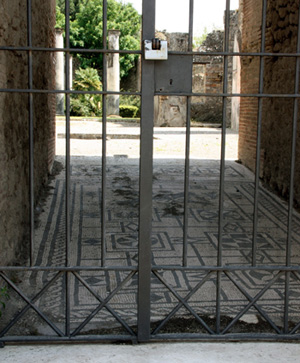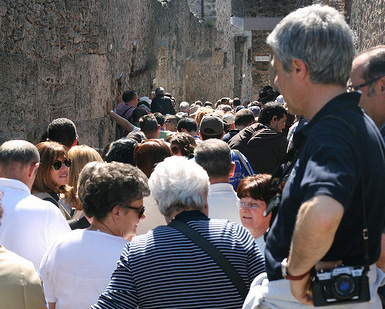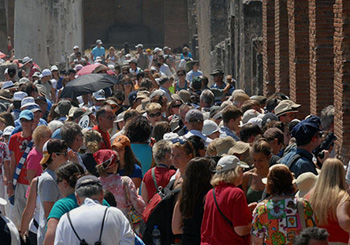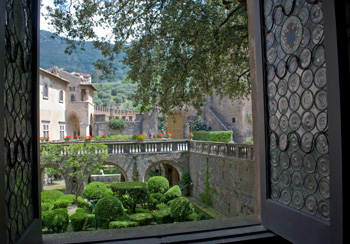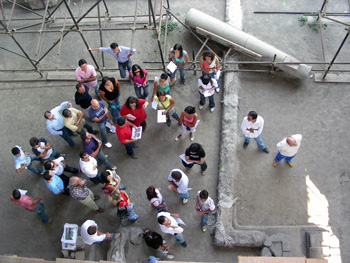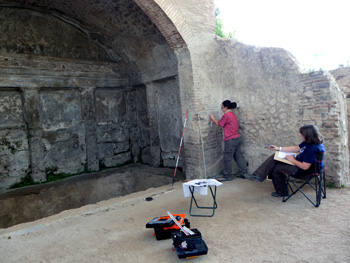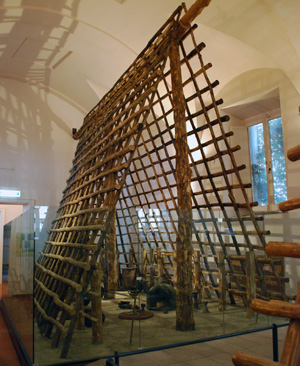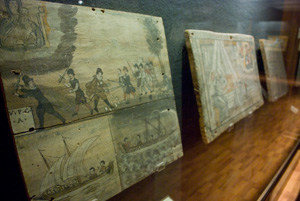Cultural Heritage and Human Development: Problems, Plans and Progress

This page will explain the Apolline Project’s position in relation to public archaeology and illustrate some of the challenges that the heritage sector in the area must overcome if it is to fulfil its purpose. A final section will provide some of the ideas being looked into as a way to improve the use of heritage in the area to benefit the public.
Problems
There are several challenges facing the heritage sector in the area, and there is no single root cause to be found. Rather, the failings that are evident in the system are the result of a combination of factors operating together. This means there are no simple answers to the problems, but it also means that blame cannot simply be assigned to any one organization. Research undertaken in preparation for the production of a localized heritage management plan (forthcoming) suggests that most problems are the result of different actors operating at crossed purposes and often without realizing the consequences of their actions.
For example, the site of Pompeii receives disproportionate investment and publicity in relation to other heritage sites – natural and cultural – in the region. This is not due to selfishness on behalf of any party, but is an unfortunate cumulative result of a range of causes, two major examples of which are provided below. This undermines the experience of tourists, leads to the devaluation and neglect of other heritage, partly by diverting badly needed resources away from other areas and contributes to an implicit but incorrect assumption about the distribution of culture in the area. These ideas will now be explored further.
The numbers game
Much has been written about the carrying capacity of particular sites. The idea is that any single site can only support so many visitors
per annum before it starts to deteriorate. Whether this is the case at Pompeii is debateable, but arguably long before this tipping point is reached the quality of the experience of visitors to sites can be greatly undermined by the quantity of tourists visiting and the system that operates in order to herd them. Many find this to be the case at Pompeii. That visiting a crowded site with many people reduces ones enjoyment is not hard to imagine, but the reasons why this is so are not always made explicit.
Although the nature of one’s experience changes depending upon the approach taken in visiting the site (as part of a guided group, as a couple with a guidebook, as a lone backpacker with a good level of prior knowledge and so forth) there are certain constants between them. One of which is that it is hard to navigate around areas of a site that are overcrowded. A visitor may grow impatient with always having to wait to enter buildings or areas of particular interest and claustrophobic when surrounded by a mass of people, particularly in restricted spaces. Furthermore, the pressure of numbers encourages people to move quickly through densely peopled areas of the site without taking the time to enjoy the experience as they might have otherwise. This can result from the pressure one may feel to let the next person ‘have their turn’. These factors acting together arguably create an atmosphere of competition among visitors. Fellow travellers become an obstruction. This negative atmosphere – not always present – between tourists naturally alters people’s experience of the sites for the worse.
Why are the sites so crowded? Again, a combination of reasons can be used to explain this. Pompeii and Herculaneum have been on the tourist map longer than most, since the European Grand Tours. They have been fixed in the imagination of the public, with numerous novels, documentaries other forms of mass media producing widespread popular knowledge of aspects of their archaeological significance and simultaneously inscribing them on people’s mental ‘to-do’ list. The sites are indeed excellent cultural resources, and are therefore highly marketable, especially when one considers the near mythical aura surrounding the sites. Widespread desire to visit the sites means a large potential market for tour operators, which has been long been exploited. This is not inherently a problem, indeed public access to the physical past is of paramount importance in accordance with the
Faro Convention.
However, as each actor in the process of tourism generation has its own agenda to pursue and is not responsible for the overall picture, the unhealthy spectacle of mass tourism has arisen. The primary aim of tour operators is to make money, and the strategy to do this reflects the realities of mass consumer culture. Prices are low and visitor numbers high. In order for many potential tourists to travel with a particular tour operator it is necessary that the price is attractive and affordable or – it is believed – that operator will lose out to the competition. If the prices are low, for the tour operator to make a profit they must make up the shortfall by processing large numbers of tourists.
To summarise, this section has argued that the mass tourism experience of cultural sites hampers their use and enjoyment by the public, and offered two major explanations for the current situation – the popularity of the idea of Pompeii and the financial incentive driving tour operators. These acting together have created the present circumstances at Pompeii and to an extent Herculaneum.
Relative Devaluation of Heritage
In a recent interview, two members of a local cultural association expressed the view that the greatest problems facing the successful management of cultural heritage in the region are firstly that people did not realize how much heritage was to be found and secondly that the heritage that people did recognise was undervalued. An appropriate analogy is to liken the situation to how economic inflation takes place. The people of Campania are fortunate to have been endowed with a copious legacy of physical heritage. Archaeological finds are commonplace and of high quality. Because there is so much well preserved physical heritage it is easy for what would appear remarkable in other contexts to seem unimpressive to those in positions of power. Even on an unconscious level comparison is inevitable.
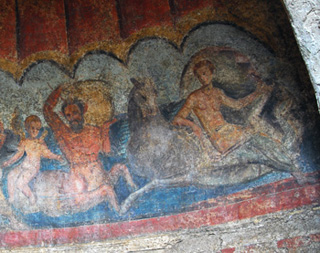
Additionally, with such a focus of activity on the coastal areas – both in tourism and research – it is understandable that many people are unaware of the vast potential of areas further inland. With so much concentration of wealth and interest at the coastal sites the cycle is self-perpetuating. Those applying for funding for research may expect to be successful if their work is related to ‘Pompeii’ which is, crudely, ‘sexy’. The prestige and interest surrounding the publication of such research is also correspondingly expected to be higher. Similarly, it appears to most people to be obvious that Pompeii and Herculaneum should be the focus of cultural tourism.
However, the alternatives are barely considered. After all, Pompeii has been built up in the collective imagination to such an extent that it is almost unthinkable to many that anything could compete with it.
Foundations to Build on
Fortunately, some realise the value of what is to be found elsewhere – including many people who live and work in areas which have hitherto not benefited from their impressive cultural patrimony. While many feel that there is room for improvement, they have also taken action to counter these perceived failings. In Italy there are numerous
Pro Loco, which are relatively small non-governmental organizations set up with a view to promoting and caring for cultural – and sometimes natural – heritage. They do this in a variety of ways. These include the provision of funds for research, the publication of local historical journals, the organization of local cultural events or providing guided tours. The people who work for these organizations come from a range of backgrounds and some may be more professional than others.
Pro Loco are not perfect organizations and the weaknesses many ascribe to early archaeologists are sometimes evident in their publications – a tendency to conflate scientific and historical approaches to the past with legend and folktales, for example. However, they do represent a body of motivated people who work actively to promote what their various regions have to offer.
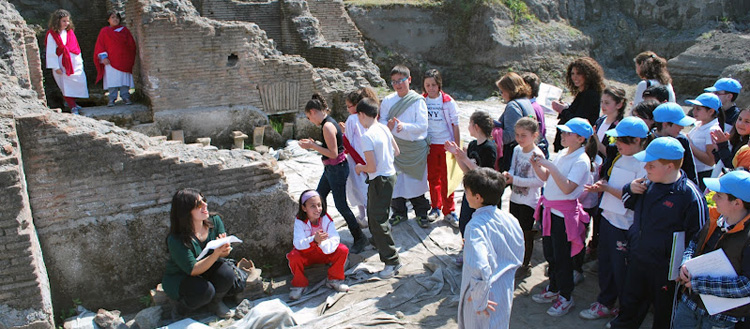
Other organizations also take part in the cultural life of the region; Universities and other academic bodies involved in excavations organize open days such as those at Somma Vesuviana with the University of Tokyo or at Masseria De Carolis in Pollena Trocchia under the Apolline Project offer an opportunity for the public to discover and engage with heritage they didn’t realize they had. Even hotels identify themselves with aspects of heritage which sometimes extends beyond merely the acquisition of an appropriately Roman themed name to organizing local tours for guests, to Mount Vesuvius, for example.
Plans
The Apolline Project aims to further promote the conservation of heritage and the public’s right of access – as laid out in the
Faro Convention – by building upon these foundations. The solution has to come from inside the region – the days of the foreign scholar paying a flying visit, righting some perceived wrongs and jetting off again belong to an era that belongs in the past. The Apolline Project can contribute by continuing to carry out and publicize academic research which can then be transformed into cultural resources for the benefit of the public. However, it is not enough to simply allow open access to all archaeological sites and museums. When people visit they should expect to receive interesting and well presented information on what it is they have come to see.
This can be facilitated through better harnessing the more innovative developments that have emerged from the field of museology. Instead of continuing with the format of the traditional museum a more holistic approach is called for.
A management plan currently being produced will contain recommendations on this aspect of public archaeology.
However, progress has already been made in this area, and the archaeological museum at Nola is one example of a local museum which has begun to integrate reconstruction with more exciting displays of artefacts and visual explanations; all of which are more engaging than much of what is available elsewhere.
In order to combat what has been seen as the most significant problem – the undervaluation of local heritage – the management plan will focus on making the heritage work in a way that actively improves the lives of people living in the region. If heritage can be made to work for the benefit of the local community, it can demonstrate its value and so it will be seen to be worth caring for. This will involve making use of sustainable alternative forms of tourism which place the responsible use of heritage at its centre. Although beginning on a small scale, the intention is to integrate different types of heritage into a packageable tour in which the valuable and unique heritage of the region can be presented to outsiders and locals alike. Much of the basic infrastructure is already in place, excellent hotels,
agriturismi, restaurants and cultural excursions already exist. The challenge is to coordinate the linking up of these component parts to allow them to meet the expectations of visitors who have grown weary of the artificial, isolating and stressful experience of mass culture tourism.
The Apolline Project was awarded the
European Archaeological Heritage Prize in 2011, and its work runs parallel to the goals of
Council of Europe Framework Convention on the Value of Cultural Heritage for Society. We consider the responsible practice of public archaeology to be a moral obligation.
The encouragement of alternative tourism is not an end in itself. The desire to better conserve cultural heritage while contributing to what is known as ‘human development’ – a more holistic approach to development which extends well beyond economic objectives – is what drives this initiative. To summarise, the aim of improving the lives of people living in the area through better preserving and utilizing cultural resources has led the Apolline Project to consider creative strategies for bringing this about. Current thinking within the project is that encouraging sustainable and responsible tourism that incentivizes the preservation of the unique and valuable heritage of the region through better coordination of actors will help us to contribute to the life of the community that has continued to generously support our work.
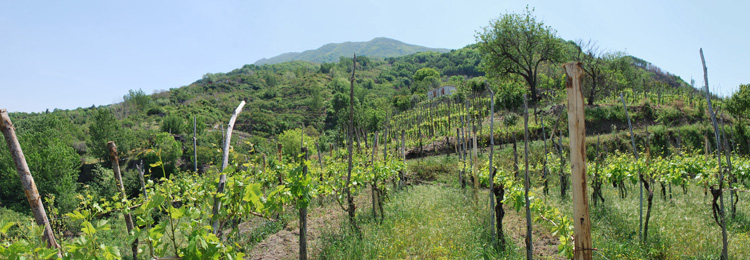
To know more:

